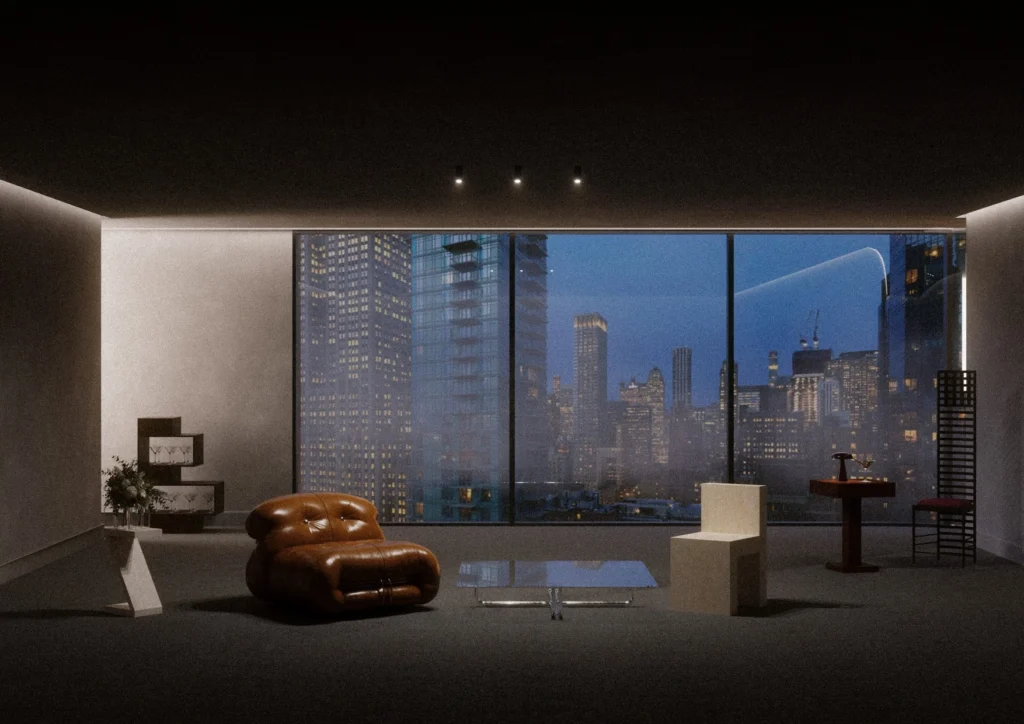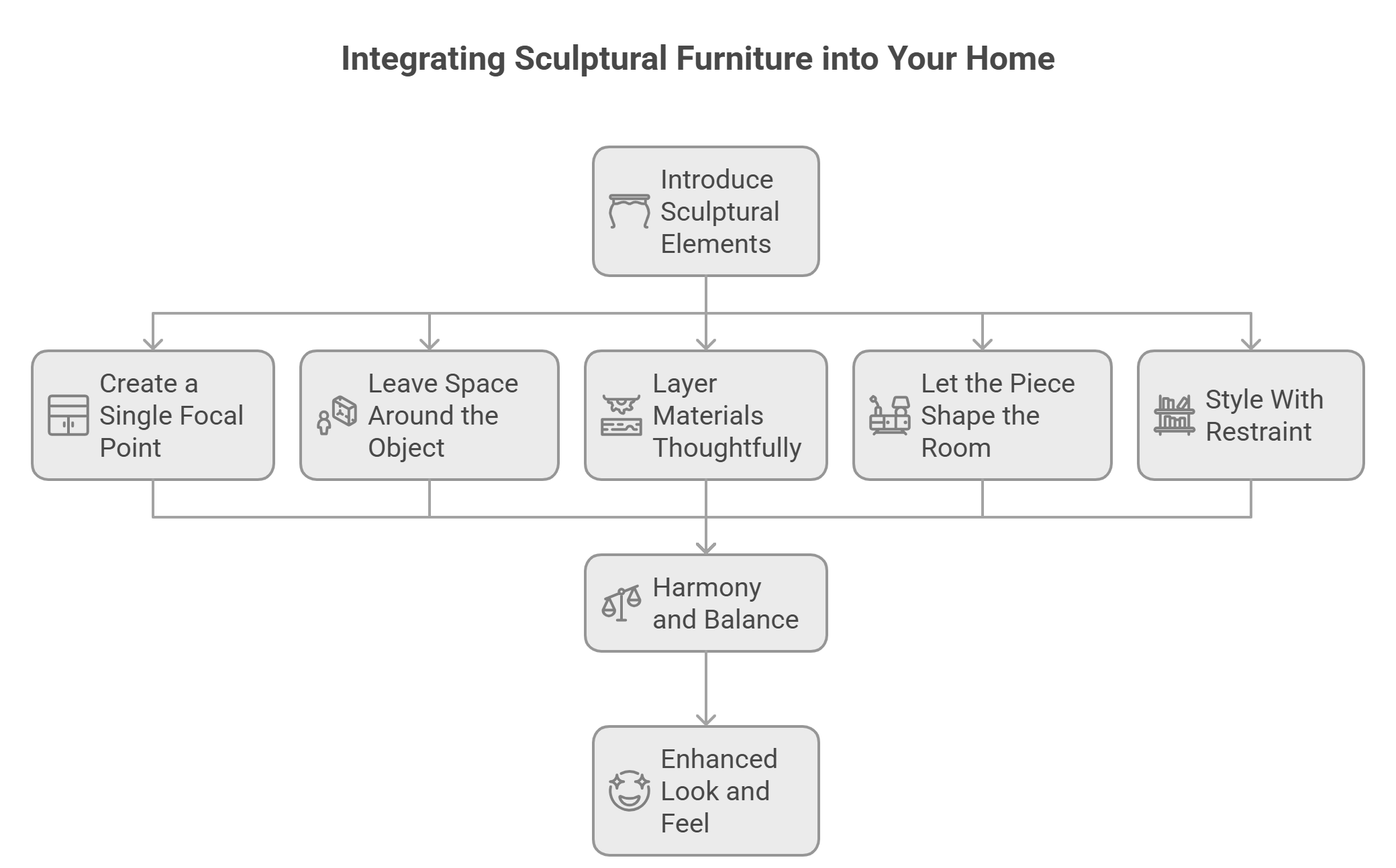
Petramadalena creates unique, sculptural furniture pieces that combine art and practicality, helping people shape spaces that truly feel like home.
In contemporary interior design, the line between practical objects and artistic expression has become beautifully blurred. More and more homeowners are seeking pieces that do more than simply fill a room—they must speak, express, anchor, and elevate the entire space. Sculptural furniture embodies exactly this transformation. It brings personality, presence, and depth into interiors, turning everyday items into meaningful artistic statements.
Sculptural design invites us to rethink the way we inhabit our homes. Instead of allowing function alone to determine form, it celebrates form as the function. Curves, planes, contrasts, silhouettes and materiality work together to create objects that enrich both visual and tactile experience. This evolution is strongly reflected in discussions across respected design platforms such as architectural design editorials and curated contemporary art-and-interior resources like modern design media, which continuously highlight the rise of sculptural elements in high-end interiors.
The essence of sculptural furniture lies in its ability to transform a room’s atmosphere. A piece may have sweeping organic lines, sharp geometric edges, or dramatic volumes intentionally designed to draw the eye. Unlike conventional pieces which focus primarily on functionality, sculptural furniture prioritises emotional impact. It introduces tension, softness, rhythm, and movement—turning everyday environments into curated artistic landscapes.
One of the most important aspects of this design approach is its ability to define space. A single expressive piece can completely redirect how someone perceives a room’s flow. For example, a rounded coffee table softens a minimalist interior, while an angular cabinet introduces architectural boldness. Material choices amplify these effects: warm natural woods evoke calmness; stone conveys permanence; metal adds contemporary edge.
This combination of material artistry and sculptural silhouette is exactly why interior designers increasingly treat furniture selection as an extension of the home’s art curation.
While sculptural furniture exists in many forms, its most powerful expression appears in bespoke pieces—objects designed specifically for the individual and their home. At Petra Madalena, this personalised approach is at the core of everything we create. Clients frequently choose designs such as custom cabinets, bespoke bookcases and a carefully crafted bespoke coffee table to form the sculptural foundation of their interiors.
Custom furniture allows absolute control over proportion, silhouette, material composition, texture and function. This means a piece can be sculpted—literally and conceptually—to align with the room’s architectural features, create balance within the layout, and convey the homeowner’s aesthetic personality.
For instance:
Every bespoke piece becomes a hybrid of function, sculpture and storytelling—something mass-produced items simply cannot achieve.
Below is a clean, concise comparison that helps readers appreciate why sculptural furniture is unique:
Feature | Sculptural Furniture | Traditional Furniture |
Primary Focus | Artistic form + functional use | Pure practicality |
Visual Impact | Strong focal element; expressive | Blends into surroundings |
Design Approach | Curves, geometry, bold silhouettes | Standardised shapes, simpler lines |
Customisation Level | High—especially with bespoke pieces like custom cabinets | Low—predefined sizes and styles |
Materials | Often natural, textural, artisanal | Industrially produced, uniform |
Role in Interior | Defines atmosphere and identity | Complements existing décor |
Longevity | Ages with character; timeless appeal | Dependent on trends and wear |
Introducing sculptural elements into a home requires thoughtful intention. The goal is harmony—not clutter, not competition, but a balanced visual dialogue between the object and the space around it.
Here are essential principles for integrating sculptural furniture seamlessly and beautifully:
Every room benefits from one anchoring sculptural gesture. Whether that gesture comes from a striking custom cabinets installation or a dramatic bespoke coffee table, clarity is key. Too many competing silhouettes weaken the overall impact.
Sculptural pieces require breathing room. Allow negative space to emphasise form. If placed against a wall, let the wall act as a gallery backdrop. If centred in the room, ensure pathways circle it smoothly.
Material contrast enriches form. Pairing wood with stone or metal elevates texture. Consider how light interacts with the piece as well—sculptural furniture thrives under intentional lighting.
A sculptural piece can influence how you position seating, lighting or even artwork. Instead of forcing it into an existing layout, allow it to lead the composition.
Especially in the case of a bespoke bookcases project or a sculptural coffee table, surface styling should enhance, not overshadow. Negative space is your ally.
This thoughtful approach ensures that sculptural furniture enhances not only the look of the space, but also the feeling of being in it.

Petra Madalena is built on the belief that furniture should live at the intersection of art and utility. Our artisans shape each piece with sculptural sensitivity—carving, bending, refining and perfecting materials to achieve harmony between visual poetry and everyday function.
A sculptural object created by hand has personality: it carries the mark of craftsmanship, the intention behind every line, the warmth of material, and the emotional depth of artisanal work. These are qualities that mass production simply cannot replicate.
Many of our design principles and styling recommendations have been explored in depth in our articles, including insights into surface styling in our guide to artful table displays inspired by decorating a coffee table and our detailed thoughts on shaping architectural rhythm in shelving, as discussed in our exploration of styling bespoke bookcases.
By integrating these ideas, homeowners can elevate both sculptural impact and functional harmony in their interiors.
Beyond aesthetics, sculptural furniture offers exceptional long-term value. It is durable, designed with purpose, and becomes part of the emotional fabric of a home. More importantly, it ages beautifully—especially when crafted from natural materials. Over time, these pieces develop character, patina, depth and stories.
Because sculptural pieces are meant to be noticed and appreciated, they often remain relevant for decades, transcending trends. When custom-made, they adapt seamlessly to future renovations or new homes, maintaining meaning and presence through changes in life.
Ultimately, investing in sculptural furniture is an investment in atmosphere, identity and quality of life.
Sculptural furniture bridges the gap between functional living and artistic expression. It brings emotional richness to interiors, turning rooms into experiences rather than simple containers for daily life. Whether through expressive custom cabinets, architecturally inspired bespoke bookcases, or a statement bespoke coffee table, these pieces offer a way to personalise space in its most meaningful form.
Petra Madalena celebrates this harmony between beauty and utility—crafting furniture that feels alive, expressive and deeply connected to the homes it inhabits.
Sculptural furniture prioritises artistic form as much as function. Unlike traditional pieces designed mainly for practicality, sculptural designs feature expressive shapes, textured materials and bold silhouettes that become focal points in a room. They act as decorative art while still offering everyday usability.
Bespoke sculptural pieces—such as custom cabinets, bespoke bookcases or a handmade bespoke coffee table—are tailored specifically to the interior. This level of customisation ensures perfect proportion, craftsmanship and long-term durability. Because they are unique and handcrafted, these pieces remain timeless and retain their value far longer than mass-produced alternatives.
Start by choosing one strong sculptural focal point per room. Give the object space around it, use complementary materials and keep surrounding décor minimal. This approach allows the sculptural piece to shine without competing with other elements in the room.
Natural, expressive materials—such as hardwood, stone, metal and textured finishes—are commonly used in sculptural furniture. These materials help emphasise form and depth, making the piece visually impactful from every angle. They also age beautifully, enhancing the furniture’s long-term appeal.
Yes. Sculptural furniture can enhance small spaces when chosen thoughtfully. A single well-designed sculptural object can make a compact room feel more intentional and curated. Slim, vertical pieces like custom cabinets or visually open bespoke bookcases can provide storage while still acting as elegant sculptural statements.